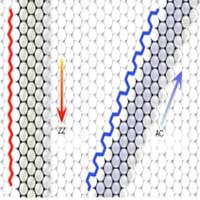 An international research team has developed 'electronic skin' sensors capable of mimicking the dynamic process of human motion. This work could help severely injured people regain the ability to control their movements, as well as contribute to the development of smart robotics.
An international research team has developed 'electronic skin' sensors capable of mimicking the dynamic process of human motion. This work could help severely injured people regain the ability to control their movements, as well as contribute to the development of smart robotics.
Monday, September 21, 2020
Engineers imitate human hands to make better sensors
 An international research team has developed 'electronic skin' sensors capable of mimicking the dynamic process of human motion. This work could help severely injured people regain the ability to control their movements, as well as contribute to the development of smart robotics.
An international research team has developed 'electronic skin' sensors capable of mimicking the dynamic process of human motion. This work could help severely injured people regain the ability to control their movements, as well as contribute to the development of smart robotics.
New nanocomposite material revs up pursuit of advanced electric vehicles
 Researchers used new techniques to create a composite that increases the electrical current capacity of copper wires, providing a new material that can be scaled for use in ultra-efficient, power-dense electric vehicle traction motors.
Researchers used new techniques to create a composite that increases the electrical current capacity of copper wires, providing a new material that can be scaled for use in ultra-efficient, power-dense electric vehicle traction motors.
Having a ball: Crystallization in a sphere
 Scientists used a droplet of a colloid as a model for single atoms or molecules in a sphere. Unlike single atoms or molecules, which are too small to easily observe, the colloid particles were large enough to visualize using a microscope. This allowed the researchers to track the ordering of single particles in real time during crystallization.
Scientists used a droplet of a colloid as a model for single atoms or molecules in a sphere. Unlike single atoms or molecules, which are too small to easily observe, the colloid particles were large enough to visualize using a microscope. This allowed the researchers to track the ordering of single particles in real time during crystallization.
Mirror-like photovoltaics get more electricity out of heat
 New heat-harnessing 'solar' cells that reflect 99% of the energy they can't convert to electricity could help bring down the price of storing renewable energy as heat, as well as harvesting waste heat from exhaust pipes and chimneys.
New heat-harnessing 'solar' cells that reflect 99% of the energy they can't convert to electricity could help bring down the price of storing renewable energy as heat, as well as harvesting waste heat from exhaust pipes and chimneys.
Towards chirality control of graphene nanoribbons embedded in hexagonal boron nitride
 Researchers report the successful control over the chirality of graphene nanoribbons embedded in hexagonal boron nitride nano-trenches, whose direction can be modulated by different catalytic cutting particles.
Researchers report the successful control over the chirality of graphene nanoribbons embedded in hexagonal boron nitride nano-trenches, whose direction can be modulated by different catalytic cutting particles.
Colloidal dispersions of nanosheets for catalysis
 Researchers have used a liquid phase exfoliation process to obtain nanosheets with enhanced electrocatalytical properties.
Researchers have used a liquid phase exfoliation process to obtain nanosheets with enhanced electrocatalytical properties.
Why there is no speed limit in the superfluid universe
 Physicists have established why objects moving through superfluid helium-3 lack a speed limit.
Physicists have established why objects moving through superfluid helium-3 lack a speed limit.
Scientists propose multifunctional liquid metal nanocapsules
 New research revealed that liquid metals can initiate free radical polymerization of vinyl monomer under ultrasonication.
New research revealed that liquid metals can initiate free radical polymerization of vinyl monomer under ultrasonication.
The right formula for scaling production of promising nanomaterial to decontaminate water
 An international team of researchers have found a way to refine and reliably produce an unpredictable and hard-to-control material that could impact environmental conservation, energy and consumer electronics.
An international team of researchers have found a way to refine and reliably produce an unpredictable and hard-to-control material that could impact environmental conservation, energy and consumer electronics.
New MXene composite material for planes and cars that will show damage invisible to a human eye
 Electrically conductive nanoparticles will be used for the composite material that could be used in advanced transport, aviation, wind turbines and other structures.
Electrically conductive nanoparticles will be used for the composite material that could be used in advanced transport, aviation, wind turbines and other structures.
Soft robots, origami combine for potential way to deliver medical treatments
 Magnetic fields allow for wireless, faster, less invasive delivery, study finds.
Magnetic fields allow for wireless, faster, less invasive delivery, study finds.
Extra stability for magnetic knots
 Scientists find a new mechanism for the stabilization of skyrmions.
Scientists find a new mechanism for the stabilization of skyrmions.
Subscribe to:
Comments (Atom)
